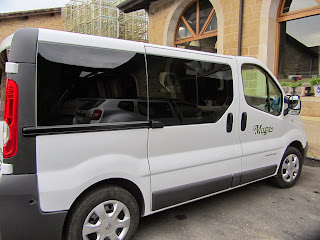This was Thursday morning, the final morning of the final day of what had been, up to this time, a scintillating trip to Haro. We had met a number of the leading lights of Rioja wine production. We had gained a better understanding of the Rioja products and production processes. We had eaten a lot of great food -- and drank some great wines. And we were scheduled to cap all of the foregoing with visits to a Bodegas Muga vineyard and the winery, followed by a trip to Briones to meet up with the broader wine blogger group for a tour of the museum and winery at Dinastia Vivanco. It was going to be a long day for those of us who had just gotten to bed a few minutes before the wake-up call.
Shortly after I had struggled downstairs and checked out, two white passenger vans rolled up to the hotel and two female drivers emerged. They introduced themselves as Ana Muga (granddaughter of the founder) and Ana Lopezcano Lamarian, PR Manager. They loaded us up and we were off to the first stop on our tour.
Bodegas Muga, which was founded in Haro in 1932 by Isaac Muga Martinez and his wife Aurora Caño, owns 251 ha (620 acres) of vineyards distributed across five properties (El Estepal, La Loma, Baltracones, La Loma Alta, and Sajazarre) and controls another 370 acres through agreements with other area winegrowers. According to the Muga website, these mostly south-facing vineyards are located in the foothills of the Obaronses Mountain in the Rioja Alta region on primarily clay and limestone soils.
After a short ride, we turned into a road which led to what appeared to be a white barn in the middle of a vineyard. We had arrived at Viña Baltracones (one of the previously mentioned vineyards) where a number of workers were fully engaged in plucking grape bunches from the vines. We pulled up to the side of the barn and was welcomed by the viticulturist who led us into the field, bringing us up to speed along the way. This year had not been an easy year, with uneven ripening across the region and stop-and-start harvesting. The grapes being harvested were Graciano which would be used to add freshness to the Tempranillo. The freshness of the grapes would be preserved by transporting them back to the winery in refrigerated trucks. During the picking process, the workers were also conducting a first-level selection of the grapes.
 |
| Doug Frost MS/MW mentally composing his next tasting note |
On our way into the vineyard I had seen white smoke rising into the sky from a metal contraption but had taken no further notice of it. On my return to the barn area, I saw that a table had been positioned in front of the barn and that a white tablecloth had been draped over said table. On the table were bottles of Cava, glasses and loaves of chunky bread. The white smoke was emanating from a fire which was being used to cook sausages for our breakfast. I had not planned on this. It was too early to eat something this heavy. Especially with lunch less than two hours away. Oh well.


The Cava served was the Muga Cava Conde de Haro, a blend of 95% Viura and 10% Malvasia sourced from north-facing, high-altitude vineyards located in the same area where the grapes for Prado Enea are grown. These grapes are fermented in large oak casks and sit on the post-second-fermentation lees for 14 months. According to K&L.com, Muga may be the first estate in the Rioja DO to grow, produce, bottle, and age Cava. This Cava was very refreshing with small, tight bubbles, nice acidity, and pear and apple fruit. Its zippiness brought me back to life.
 |
| Ana Lopezcano Lamarian and Ana Muga |
 |
| Umay and his little red book |
 |
| Robert smiling because he will soon be rid of us |
 |
| Isaac Muga -- can you hear me now? |
 |
| It's all good |
 |
| joie de vivre |
After observing the pickers in the field, partaking of a hearty breakfast, and hamming it up for the cameras, we loaded up and headed to the next stop -- the winery.
©Wine --
Mise en abyme


















No comments:
Post a Comment